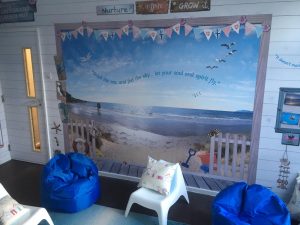GREYSBROOKE’S NURTURE ROOM – HOW THE RIGHT ENVIRONMENT NATURALLY HELPS TO NUTURE
We’re living in a world where our young school pupils have to deal with ever- increasing pressures. From the emotional distress caused by problems at home, low self-esteem and anger issues to the tremendous worries brought about by the pandemic – not least lockdown and home-schooling taking them away from their friends – there are many factors that can have a detrimental effect on a pupil’s mental state.
However, Greysbrooke Primary School, based in Staffordshire, has striven to help support its pupils through emotionally difficult times with the creation of its own dedicated Nurture Room.
Why have a Nurture Room?
Ellie Ballinger, headteacher at Greysbrooke said, ‘Our staff had been noticing a steady decline in our pupil’s mental health, which appeared to be worsening year on year. Whilst we pride ourselves on good relationships with parents (we are usually informed of any family issues that could affect a pupil) and we are heavily engaged in raising awareness amongst our students around issues such as social media usage and cyber-bullying, we felt that there was still more that we could do to help support all of our children, especially those with specific emotional needs.
‘Following discussions within the school and ascertaining the extent of the issue, we decided to create our Nurture Room. We felt that the investment would yield great results in the form of more resilient, well-balanced children who would be more ably equipped to deal with their emotional issues. By providing them with the tools to help them communicate more effectively, we hoped it would, in turn, have a very positive effect on their academic studies. A dedicated Nurture Room, distinct in design from classrooms, would provide a welcoming and relaxed space within the school for us to work with our pupils in a productive and structured way.
Life’s a Beach
‘We worked closely with Two Thirds Design, a company that has extensive experience working with educational establishments, on how our Nurture Room should look and feel. From the start, they understood exactly what we were trying to achieve, and having discussed our objectives, helped to bring our ideas to life.
‘Themed around a Beach Hut (who doesn’t enjoy the calm and relaxation of the seaside?), the Nurture Room featured a realistic beach-side scene, flanked by colourful bunting, sunny postcards and holiday photographs, all aimed at transporting the children away from the classroom environment.
‘There is not a desk in sight – just child-friendly furnishings. Blue beanbags, relaxed-style chairs, soft seaside-themed cushions and small tables for carrying out activities or simply for biscuits and juice (which can’t be underestimated for helping a child to feel special and listened to) help to deliver the relaxed ‘Beach Hut’ feel we were after.
‘Attention to detail, in both design and execution was second to none, whilst installation was quick, easy and with minimum disruption – essential for the smooth-running of the school. The impressive end result was well worth all the effort.
An invaluable resource
‘At Greysbrooke, we are fortunate enough to have Emotional Literacy Support Assistant (ELSA) trained teachers, who are trained to support the emotional needs of their pupils within school. These specialist skills help allow for one-to-one sessions with a child, where specific and measurable targets are discussed with the child.
‘Of course this process can be difficult, but the Nurture Room, with its calm and secure environment, really helps children to feel safe and able to talk more freely allowing us as teachers to substantially build on our nurturing ethos. Only once this first critical stage is complete can we decide upon the right course of action for each individual child.
‘Strategies might include LEGO®-based Therapy – a collaborative, play-based social skills intervention designed to improve social competence in children with social difficulties. Originally designed to treat children with autism, it has now been widened to children with related conditions.
‘Likewise, Art Therapy is a strategy used within the Nurture Room, with the opportunity for children to produce work that is both meaningful and personal to them whilst encouraging them to think about the message of the session – the ‘nurture focus’ – such as ‘developing positive self-talk’.
‘Our ELSA-trained staff have noted that, as a result of these types of session, children become much more aware of how to communicate with each other and what behaviour is acceptable within the session. Confidence has increased and behaviour is far calmer with the children having grown and developed in a positive manner. The Nurture Room environment, being both calm and positive, helps children to relax and feel special whilst focussing on their tasks.
‘Our Beach Hut-themed Nurture Room has been a great success. During its first year, 47 children received some form of nurture session/support within the Nurture Room – that’s 23% of the whole school who have been impacted in a positive way.
‘My teaching colleagues have seen an increased love of school, confidence, attainment and self-esteem and talk of the pupils’ excitement and desire to work in the Nurture Room. In addition, several parents have approached me asking whether their child might benefit from nurture provision, such is the need for this kind of support.
‘As a school, we have been over-whelmed by the success of the Nurture Room. It provides a calm and purposeful learning space for children who really need it – and at any time, but especially now, nothing could be more important.
